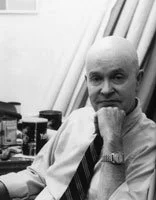GENE DAVIS (1920-1985)
Available Work | Biography
Biography • Gene Davis (1920-1985)
Gene Davis
Gene Davis was born in Washington, DC. He was a career journalist from 1939 to 1969, working as a sports reporter and then as a White House correspondent. He began to paint in 1949. Davis found inspiration visiting the Phillips Collection in Washington, where he encountered works by Paul Klee, Arshile Gorky, and the Impressionists, and was fascinated by their innovative uses of color. Davis’s work from the early 1950s had abstract patterning influenced by Klee. He befriended the artist and curator Jacob Kainen and became associated with the Washington Workshop Center for the Arts. Davis met Kenneth Noland when Noland was a teacher at the Institute of Contemporary Arts, DC around 1950 and Morris Louis at the Washington Workshop Center in 1953.
Although based in DC, Gene Davis traveled to New York regularly to see new art at both the museums and galleries, particularly shows at Sam Kootz Gallery, Stable Gallery, and Betty Parsons Gallery. Davis’s attitude towards art was impacted by an exhibition of Barnett Newman’s zip paintings at the Betty Parsons Gallery in 1951. Davis had his first solo exhibition of black and white ink drawings organized by Jacob Kainen at the Dupont Theater Gallery in the fall of 1952. Noland saw the exhibition and offered Davis an exhibition at Catholic University in 1953. Starting in 1958, Davis produced paintings of colored vertical stripes arranged rhythmically and intuitively, rather than by formula or theory, to explore the effects of color interaction. He exhibited two of his new stripe paintings in his second exhibition at the Dupont Theater Gallery in 1959, alongside works with circular motifs in thinly diluted paints. By the end of 1959, Davis settled on a fixed format of vertical stripes across the entire canvas. He exhibited one of his stripe paintings in a group show at Jefferson Place Gallery in 1960, followed by a solo exhibition entirely of stripe paintings there in January of 1961. Davis referred to his stripes as “intervals” as they set up a repeated composition to explore color. From 1959 to 1961, the stripes in his paintings varied between consistent and changing widths followed by more regular thick stripes from 1962 to 1968. In 1969 Davis began a freer approach to the intervals in his paintings with the stripe as a unit of time and spaces of raw canvas to break the unity of the whole. In the 1970s, Davis began to employ lines as fine edges with a paler palette fading in and out across the canvas.
Gene Davis had his first New York solo exhibition at the Poindexter Gallery in 1963 where he has further solo shows in 1965, 1966, and 1967. Davis was then represented by Fischbach Gallery with solo exhibitions every year from 1967 to 1974. Davis received his first museum solo exhibition at the Corcoran Gallery of Art, Washington, DC in 1964 followed by further exhibitions there in 1969 and 1970. Another solo exhibition organized by Gerald Nordland was held in the spring of 1968 at the San Francisco Museum of Art. Further exhibitions include his 1970s paintings organized by the Walker Art Center, Minneapolis, MN in 1978 which traveled to two further venues; an exhibition of 30 years of drawings at the Brooklyn Museum in 1982; and recent paintings in 1983 at the Delaware Art Museum in Wilmington. In 1969, Davis began teaching at the Corcoran School of Art and Design, and he later taught at American University, Skidmore College, and University of Virginia.
Gene Davis was identified along with Thomas Downing, Kenneth Noland, Morris Louis, Howard Mehring, and Paul Reed as part of a movement in the exhibition Washington Color School Painters organized by Gerald Nordland at the Washington Gallery of Modern Art in 1965. Outside of DC, Davis was included in many major exhibitions of the 1960s including: Post Painterly Abstraction at the Los Angeles County Museum of Art in 1964; The Responsive Eye in 1965 and The 1960s in 1966 at the Museum of Modern Art, New York; Large Scale American Paintings at the Jewish Museum, New York in 1966; and Color, Image, and Form 1967 at the Detroit Institute of Arts. Davis was included in Marcia Tucker’s exhibition The Structure of Color at the Whitney Museum of American Art, New York in 1971 and Color Field Painting to Post-Color Field Abstraction: Art for the ‘70s at the Nelson-Atkins Museum of Art, Kansas City in 1972.
Works by Gene Davis are in the collections of the following Washington DC art institutions: the National Gallery of Art; the Phillips Collection; the Smithsonian American Art Museum; and the Hirshhorn Museum and Sculpture Garden. In addition his work can be found in the Museum of Modern Art, New York, NY; the Metropolitan Museum of Art, New York, NY; the Solomon R. Guggenheim Museum, New York, NY; the Art Institute of Chicago, IL; the Cleveland Museum of Art, OH; the Museum of Fine Arts, Houston, TX; and the Philadelphia Museum of Art, PA. When Gene Davis died, the Smithsonian American Art Museum in Washington presented a memorial exhibition in his honor.



